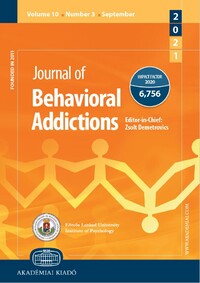Hands-off: Feasibility and preliminary results of a two-armed randomized controlled trial of a web-based self-help tool to reduce problematic pornography use
Hands-off: Feasibility and preliminary results of a two-armed randomized controlled trial of a web-based self-help tool to reduce problematic pornography use
Author(s): Beáta Böthe, Christian Baumgartner, Michael P. Schaub, Zsolt Demetrovics, Gábor OroszSubject(s): Behaviorism
Published by: Akadémiai Kiadó
Keywords: cognitive-behavioral therapy; compulsive sexual behavior; feasibility; online intervention; problematic pornography use
Summary/Abstract: Background and Aims. Despite problematic pornography use (PPU) being prevalent, no previous study has examined the effectiveness of evidence-based interventions for PPU, using rigorous methods. Using a two-armed randomized controlled trial study design, we examined the feasibility and initial effectiveness of a six-week online PPU intervention. Methods. We recruited 264 participants (3.8% women, M age = 33.2, SD = 10.6) who were randomized and assigned to either the self-help intervention (n = 123) or waitlist control condition (n = 141), and completed self-report questionnaires at baseline and after the end of the intervention (six-week follow-up). Multivariable linear regression models were generated and tested on a complete case basis to investigate possible treatment effects. Participants provided quantitative and qualitative feedback regarding the intervention’s content and appearance. Results. Participants evaluated all modules positively in the intervention in general. There were differential dropout rates (89.4% in intervention vs. 44.7% in control group) with an overall follow-up rate of 34.5%. The intervention group reported significantly lower levels of PPU (P < 0.001, d = 1.32) at the six-week follow-up. Moreover, they reported lower pornography use frequency (P < 0.001, d = 1.65), self-perceived pornography addiction (P = 0.01, d = 0.85), pornography craving (P = 0.02, d = 0.40), and higher pornography avoidance self-efficacy (P = 0.001, d = 0.87) at the six-week follow-up. Discussion and Conclusions. The present study was only a first step in rigorous treatment studies for PPU, but the findings are promising and suggest that online interventions for PPU might help reduce PPU in some cases, even without the guidance of therapists, by reducing treatment barriers.
Journal: Journal of Behavioral Addictions
- Issue Year: 10/2021
- Issue No: 4
- Page Range: 1015-1035
- Page Count: 21
- Language: English

